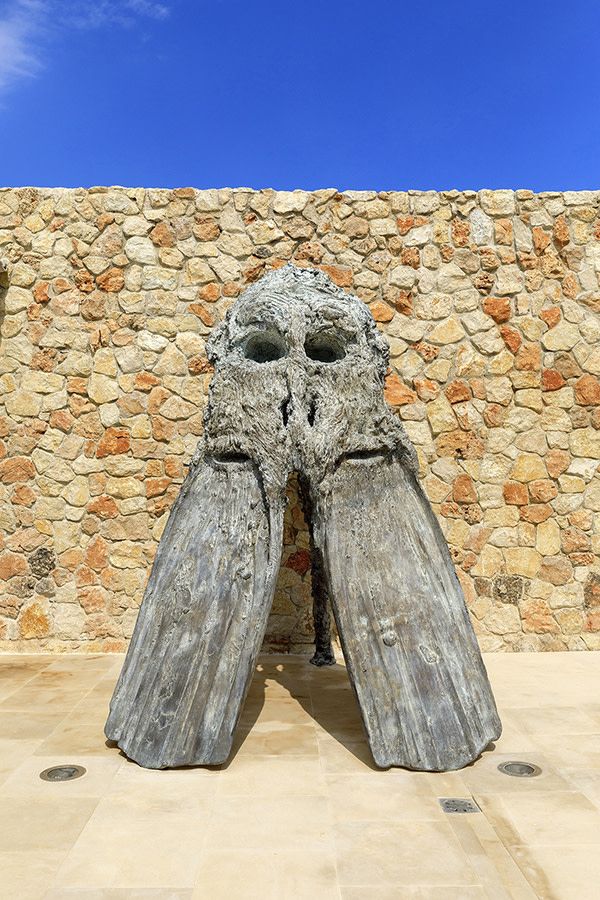The Villa

“This place was created for the pleasure of sharing what I love with as many people as possible. I prefer the word “share” to word “transmit”. That is why I like accessible works. Art needs to speak.”
Edouard Carmignac
At first, there was a farm, seen in “Pierrot le fou”, the Jean-Luc Godard movie. In the 1980s, Henri Vidal, an architect and inventor of reinforced earth, transformed the farm into a villa. Invited to the wedding of one of his daughters, Édouard Carmignac fell in love with the estate. He subsequently imagined turning it into a place dedicated to the arts. This project has unfolded over the last few years, thanks to the involvement of Atelier Barani for the design, and the GMAA agency for the project’s adaptation and extension.
The Villa Carmignac is set at the heart of a National Park and on a listed site. Additional construction is not authorized on the land. The entire project has thus consisted of clearing 2,000 square meters of space beneath the surface, without modifying the house’s contours or the existing landscape.
Inside the villa, the spaces expand and extend in the shape of a cross. In the center, an
aquatic ceiling lets in natural light and illuminates these underwater spaces. The visitor walks freely around voluminous spaces marked by visual openings onto the vineyards.
In technical terms, the building meets all of the museum standards, in a sober design that fits into the landscape, enabling the Villa Carmignac to welcome the best works under optimal conditions.
The Villa
The Villa's permanent works
Miquel Barceló
Born in Felanitx, Spain, 1957

Alycastre, 2018
Welcoming visitors at the entrance of Villa Carmignac, this imposing sculpture by the Spanish artist Miquel Barceló is inspired by the mythical figure of the Alycastre, the legendary dragon of Porquerolles. The myth narrates that Ulysses, on the road to Ithaca, ran ashore on a beach of the island and had to fight the animal, which had been sent by Poseidon. Conquered by the hero, the noble creature asked that this place bear his name. Half skull and half sea monster, this sculpture by Miquel Barceló appears to guard the Villa. It recalls both the mythological universe of the Odyssey and the world of piracy that raged for a long time on the island, the many caves of the island would have been used to hide the loot. These are also popular themes of exploration for the Spanish artist who is passionate about cave art and the seabed, a recurring motif in his work.
Miquel Barceló
Born in Felanitx, Spain, 1957

Not yet titled, 2018
The idea for this extraordinary painting, specially commissioned for the Porquerolles site, came to the Spanish artist Miquel Barceló after a swim on the island. The octopus he saw when diving finds itself in this monumental aquatic landscape, amongst representations of other specimens, also oversized. All are bathed in natural light and seem to evolve serenely in the enveloping canvas. The work joins another painting by Barceló in the collection, also on the theme of the seabed, a passion particularly conducive to experimentation for this artist.
Bruce Nauman
Né en 1941 à Fort Wayne, États-Unis

One hundred fish fountain, 2005
This permanent work exists within the context of the animal sculptures that Bruce Nauman has been making since Carousel (1988). The hybrid and tragic creatures of early years have given way to realism and life. The seven types of fish perfectly represented here are those that the artist used to fish as a child: catfish, salmon, seabass, whitefish….
Repetition, noise, silence and the impenetrability of the installation gives this work a particular sense of life. One Hundred Fish Fountain, a work that resonates in this insular setting, instilling the human condition with both gaiety and gravity.
Janaina Mello Landini
Born in São Gotardo, Brasil, 1974

Ciclotrama 50 (wind), 2018
The Brazilian artist Janaina Mello Landini weaves and decorates space the way someone twists and unravels a piece of rope. Known for her large site-specific installations, which she has been developing for the past eight years and naming Ciclotramas, she seeks to create works that capture experience and redefine spaces through a network of paths, movements and flows made up of interconnected and interdependent entities. The entanglement of ropes and nylon threads, which Janaina Mello Landini unravels, weaves and rearranges, creates a physical tension across imaginary networks. The choreography created by the coiling and intertwining of strands that at times float in space and at other times are attached to props produces an organic whole. Reminiscent of such natural elements as plant roots, nerve endings or microscopic structures, the Ciclotramas strive to recreate a kind of social mapping of individual networks that evoke the infinite interconnections and interdependencies of our existence across different living systems.
Tony Matelli
Born in Chicago, United States, 1971






